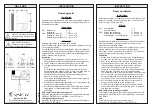
Troubleshooting
Problem
Possible reason
Solution
LED indicator is off. The
machine is not working.
The mains plug is not plugged into
the mains socket.
The on/off switch is in the off
position.
Ensure that the mains plug is
plugged into the mains socket.
Move the on/off switch to the on
position (
I
= on).
The LED indicator is
on and the humidifier is
generating an air flow,
but there is no mist.
Check that there is enough water
in the tank.
The water level switch is not
covered properly.
There is too much water in the tank.
Fill the tank with cold water.
Remove and then reinsert the water
tank. The tank must be inserted
in the correct position to avoid
covering the water level switch.
Empty some water and then reinsert
the water tank.
The mist has an
unpleasant smell.
You are using the humidifier for the
first time.
The water in the tank is stale.
Remove the tank lid and let the tank
stand for at least 12 hours in a cool
location.
Rinse the tank with clean water.
The humidifier only
generates a small
amount of mist.
The mist setting is too low.
There are limescale deposits inside
the appliance.
Blockage due to contaminated
water.
Increase the mist setting using the
control wheel.
Clean the vaporiser.
Remove the blockage and fill the
tank with clean water.
Abnormal sound.
Resonance due to insufficient water
in the tank.
Resonance due to improper
installation.
Fill the tank with clean, cold water.
Place the humidifier on a stable,
level surface.
Mist leaks from the
edges of the spray
nozzle.
There are gaps between the spray
nozzle and the water tank.
Soak the nozzle in water before use.
Reduce the mist intensity using the
control wheel.
Ventilate the room.
Water condenses on the
humidifier.
The mist intensity is too high.
The humidity of the room has
reached saturation point.
Water does not flow from
the tank.
The hole on the tank lid is blocked.
Clean the hole on the tank lid.
Maintenance and cleaning
a) General information
• Never use aggressive detergents, rubbing alcohol or other chemical solutions, as these could damage the
housing or even impair the functioning of the product.
•
Unplug the humidifier from the mains socket.
•
A dry, soft and clean cloth is sufficient for cleaning. Do not press too hard on the housing, as this can lead
to scratch marks.
• Dust can be easily removed using a soft and clean long-haired brush and a vacuum cleaner.
•
Do not place the humidifier or any of its components in a dishwasher.
•
Never submerge the humidifier under water or allow water to enter the holes on the side of the appliance.
b) Removing limescale deposits
•
If the water in your area is very hard, limescale deposits may form inside the humidifier. This may lead to a
gradual drop in the amount of mist produced. To avoid impaired function, clean the vaporiser regularly with
water and vinegar. Do not use ammonia-based cleaning agents. You are advised to clean the vaporiser
each time you refill the tank using a small, fine brush such as a toothbrush. Follow the steps below to clean
the vaporiser using a fine cloth:
- Empty the tank. Dampen the cloth with vinegar and carefully rub the vaporiser (located above the control
wheel) until the limescale deposits have been removed.
- Wipe the vaporiser dry with a dry cloth. If necessary, leave the vaporiser to dry.
• Clean the water tank at least once per week. Proceed as follows:
- Fill the water tank with clean water and add a few drops of bleach or disinfectant.
- Replace the lid and shake the contents of the tank. Empty the contents of the tank and rinse it 2 to 3
times with clean water.
Fungi and bacteria may multiply if water is left in the tank for long periods. These germs will then
be released into the air together with the mist and may cause health problems.
Storage
•
Use the packaging box to store the humidifier.
•
Empty any water from the tank. Clean the humidifier and all its components, and then wipe them dry.
• Leave the water tank lid loose or remove it completely to prevent it from becoming stuck to the tank.
Disposal
Electronic devices are recyclable waste and must not be disposed of in the household waste. At
the end of its service life, dispose of the product according to the relevant statutory regulations.
You thus fulfil your statutory obligations and contribute to the protection of the environment.
Technical data
Operating voltage ................................. 230 V/AC, 50 Hz
Protection class .................................... II
Protection rating ................................... IPX0
Power consumption .............................. 30 W
Noise level ............................................
≤35 dB (A)
Room size ............................................. Max. 25 m²
Tank volume ......................................... 3 l (full tank provides 8-10 hours of use)
Cable length ......................................... 1.5 m
Operating conditions ............................. -10 to +40 °C, 10 - 80 % RH (non-condensing)
Storage conditions ................................ 0 to +60 °C, 10 - 90 % RH (non-condensing)
Dimensions (W x H x D) ....................... 270 x 300 x 200 mm
Weight .................................................. 1.23 kg
This is a publication by Conrad Electronic SE, Klaus-Conrad-Str. 1, D-92240 Hirschau (www.conrad.com).
All rights including translation reserved. Reproduction by any method, e.g. photocopy, microfilming, or the capture in
electronic data processing systems require the prior written approval by the editor. Reprinting, also in part, is prohibited.
This publication represent the technical status at the time of printing.
Copyright 2016 by Conrad Electronic SE.
*1465107_v1_0916_02_DS_m_(1)_4L


























